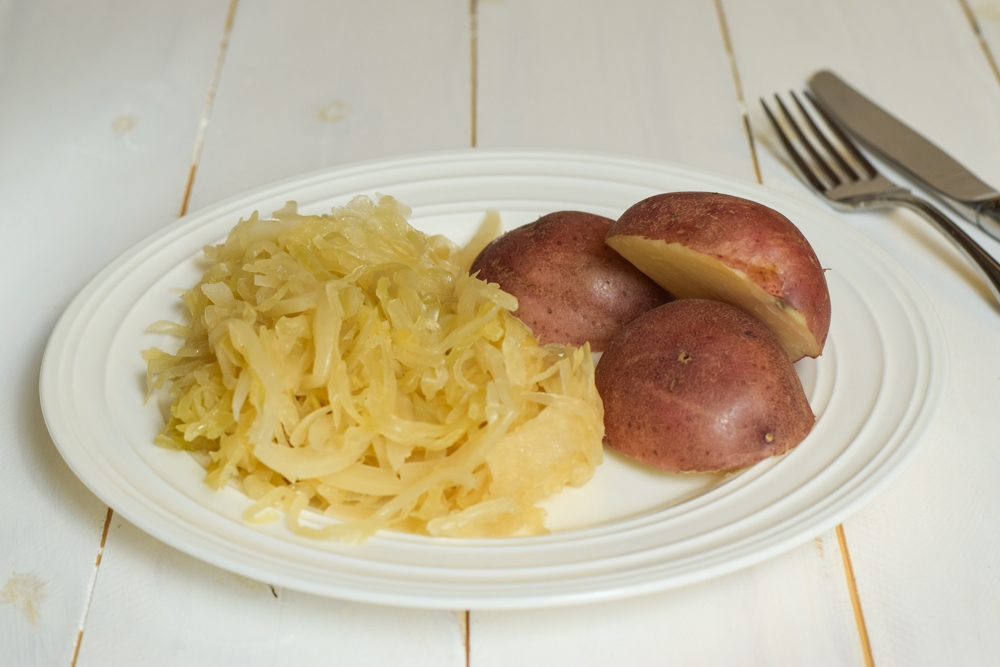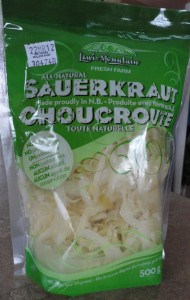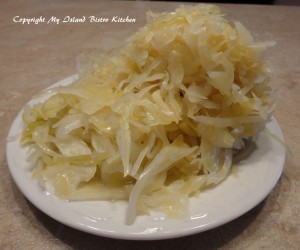
Growing up, pickled cabbage was often on the menu in winter at our house. Some might know this dish by its more sophisticated name of “sauerkraut.”
Making pickled cabbage was always a labour intensive (and messy) exercise. The cabbages had to be chopped into chunks, cores removed, then placed, layer by layer, with coarse salt into a large earthenware crock. Each layer would be tamped down with a stick that had a block on one end that was fitted with blades. This did two things. First, it chopped the cabbage up into bite-sized pieces and, second, it drew the water out of the cabbage which, when combined with the salt, made a pickling brine. As soon as juice from the salt and cabbage appeared, in went more cabbage and salt. This process continued until the crock was full. Then, a large plate was placed on the top of the cabbage and pressed down with a heavy weight (like a large brick or two). This squeezed the cabbage mixture and forced the water in the cabbage to be drawn out so the brine would form and then the fermentation process would start. The crock would be placed behind the wood stove in my grandmother’s kitchen. The heat would facilitate the fermentation process that would last several days. The “brew” would be checked every day to see if small bubbles appeared around the top of the crock which would signify that the mixture was “working” (fermenting).
After the fermentation period was completed, the cabbage would be frozen. To cook the cabbage, a piece of pork (with bone in) would be put in a large pot of water and a hefty amount of the pickled cabbage added. My grandmother would simmer this on her wood stove for probably a couple of hours or more because cabbage takes a long time to cook. The tantalizing smell of the pickled cabbage cooking would permeate throughout the house and whet the appetite on a cold, frosty winter day!
Over the years, I’ve tried a number of different commercial varieties of sauerkraut but none of them ever compared to the pure homemade variety of pickled cabbage I grew up with. I took the notion this winter to make a batch of my own pickled cabbage but that met with little enthusiasm around me. One day at my local supermarket, I happened to notice a brand of pickled cabbage (cum “sauerkraut”) that I had never seen before. Since I didn’t get much (read “any”) encouragement to make my own, I decided to try a package of Lewis Mountain Sauerkraut that was made in New Brunswick. I knew as soon as it started to cook that it smelled just like what I used to remember our homemade pickled cabbage smelling like!

It was tradition in my family to serve blue potatoes boiled in their jackets to accompany the pickled cabbage. I don’t know why blue potatoes but that was what “went with pickled cabbage” at home. I couldn’t find any “blues” so I served boiled red potatoes. I was so pleased with the Lewis Mountain pickled cabbage (they call it “sauerkraut”). It tasted just like what I grew up with. It’s an all natural product – no additives, no preservatives and I believe that’s what gives it its true, authentic flavour.

I know some serve sauerkraut with sausages and in a myriad of other ways. However, in my books, it is never better than when simply boiled as a vegetable flavoured with pork and served with boiled potatoes dressed with butter and seasoned with pepper. The cabbage does lose its color when pickled and then again when boiled so don’t look for it to have that ‘spring green’ color of fresh cabbage. However, the wonderful naturally pickled taste makes up for the loss of color. My guess is that, if you didn’t grow up with this as menu item, it is probably something that would require an acquired taste.
It’s hard to make an attractive plate with pickled cabbage served only with boiled potatoes. However, my goal was not to create a designer repas with this dish but rather to enjoy a traditional, plain, wholesome Maritime winter meal.

I’m thrilled to have found a Maritime producer that makes pickled cabbage that tastes just as I remember it as it gave me my pickled cabbage “fix” that I was craving this winter without me having to do all the work to make it!

